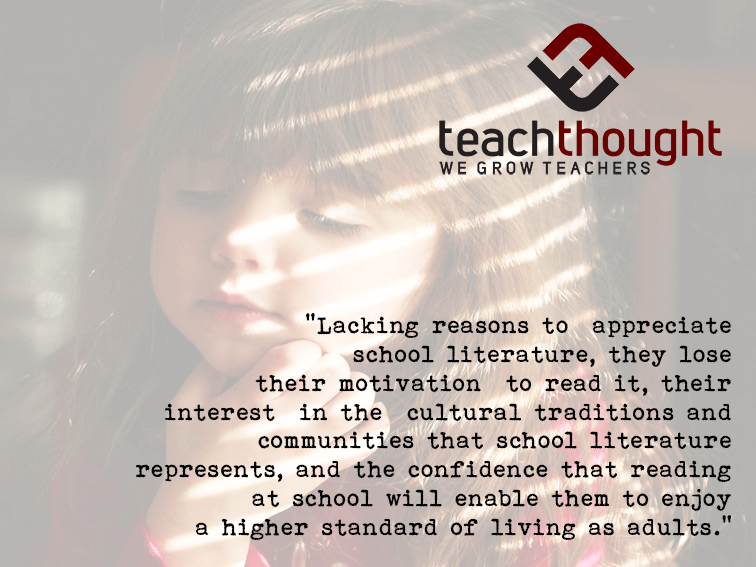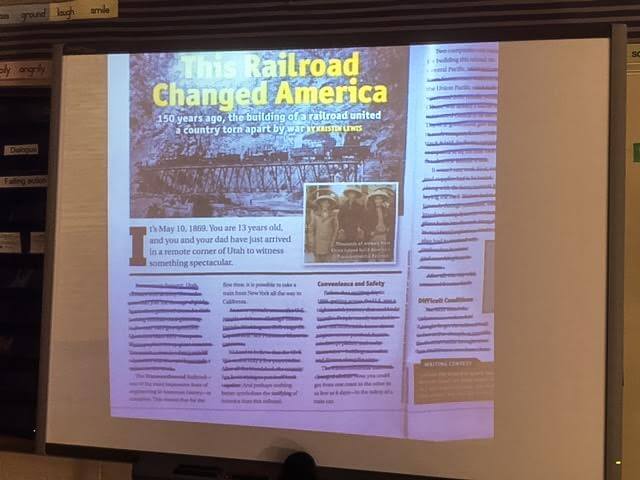
Using The Text Reduction Strategy To Improve Reading Comprehension
by TeachThought Staff
Literacy is the bridge to academic performance.
Right or wrong, the ability to read and write well is crucial to success in the modern classroom. Literacy skills, including decoding, fluency, reading comprehension, and writing among countless others, can allow students to ‘understand’ and master academic content, or make it almost impossible.
Most English-Language Arts curriculum, for example, is text-centered because the Common Core Standards are text-centered. Curricula is then text-centered, as are assessments and other measures of student understanding. Put simply then, if it helps them read or write better, it can strengthen everything else they do.
Improving reading comprehension skills is often accomplished through the application of key and learner-specific strategies, and practice. Driving questions here include, “What are the strengths and areas for growth of this particular student, and what strategies and related support can be provided so that they may sustainably improve?”
One literacy strategy that can be useful in a variety of content areas and grade levels is the Text Reduction Strategy.
What Is The Text Reduction Strategy?

The Text Reduction Strategy is a means of reducing a text, usually in order to reveal themes or important details.
Put crudely, students remove ‘stuff’ to distill a reading down into its essence: theme, thesis, main idea, etc.
Put more specifically, students remove punctuation, words, sentences, subheadings, and other text features until only what’s desired remains.
If students were using Text Reduction in order to ‘reveal’ the main idea of a passage, they’d simply use a marker to ‘delete’ words and sentences until the words left unmarked expressed–hopefully accurately and in a way that makes sense–the main idea of the passage.
Why Text Reduction can be effective is another means of understanding it from a literacy perspective. When readers are asked to identify the main idea of a reading, they have to decode words and recognize syntax to follow an argument that extends the full length of a reading. They then have to prioritize ideas, synthesize those that seem most critical, and paraphrase them into an idea that is, more or less, their own. For master readers, it’s not difficult, but for even intermediate readers it’s easy to miss crucial (often implicit) ideas and ultimately ‘create’ a skewed and inaccurate main idea.
Using Text Reduction, the words are already there. Critical thinking is still necessary–how else can they decide if a term or phrase is ‘important’ or not–but the process is less threatening. They’re finding instead of creating, similar to the difference between a multiple-choice and short response assessment item.
And by physically interacting with the text, readers are forced to engage with concepts in ways that are sometimes new and are certainly constructivist in application.
Using Markable Texts To Practice Text Reduction

Scholastic Magazine provided my classroom with a set of Scholastic Scope magazines so that we could use them to practice literacy skills and build content knowledge. We were beginning a project-based learning unit on ‘passion projects’–projects driven by topics, subjects, and areas of interest that are personal and important to students (think Genius Hour in PBL form).
I started out by modeling Text Reduction in order to reveal the main idea, using a short passage from the November 2016 issue. In this passage, one take on the main idea could be that after years of civil war, the country was once again working together to build one of America’s greatest accomplishments, the Transcontinental Railroad. I used a Think Aloud Strategy as a way of guiding the students through my decision-making process, even going back once or twice and changing my mind about the importance of a word or phrase to emphasize that reading is a recursive, ongoing, and constructivist process. Texts aren’t ‘things’ to be ‘completed’ but rather journeys to participate in.
One student made the connection to railroad crossing signs while I was explaining symbols. We had a quick discussion on the importance of symbols to give large amounts of information in quick, easy to digest formats; how seeing the sign while driving communicated important information to the driver.
Using the Gradual Release of Responsibility model (Show me, Help me, Let me), my next step was to ‘let’ students practice on their own, which I let them do in small groups of three. During this activity, students would choose between two passages from the Scholastic Magazine, and use Text Reduction to eliminate words until only a single sentence remained that reflected the ‘main idea’ of the passage.
Students grasped the gist of Text Reduction and weren’t shy about ‘deleting’ words and phrases. In fact, I noticed that they were often a bit too eager, striking out elements of the passage that were necessary to demonstrate the main idea. This, though, wasn’t a huge concern as I was able to address this one-on-one in small groups with students, and would look for it more closely during the ‘Let me’ stage of the process where they would reduce a text on their own.

The article, Swimming for Her Life, from the November 2016 issue of Scholastic Scope explored how incredible sacrifices can lead people to compete at elite levels. Most students recognized this, and their text reduction efforts indicated as much. On their own, students took 15 minutes to reduce the text using the following assignment criteria.
Assignment: Use the Text Reduction Strategy to reveal the Main Idea of the given passage. The Main Idea must be communicated in a single, complete sentence and accurately reflect the overall message of the reading.
After the 15 minute period, four students weren’t completely finished but were close enough that they could participate in the whole class activity. Next, I had students write down their ‘sentence’ on a separate sheet of paper to speed the sharing out of responses. From my reading over the shoulders, I identified four students whose Main Idea I assessed as ‘Strong’” and two I identified as ‘Developing’ and had them read their Main Idea out loud, and explain briefly how they decided which text to omit and which to keep.
For this activity, the main objectives as I see them were literacy engagement and modeling of ‘passion.’ It was less about whether or not the “Main Ideas” were perfect, and more about:
- Whether or not students would use this activity in the future on their own if they needed help identifying Main Idea.
- Students could see how the Olympic swimmer Yusra Mardini demonstrated self-directed passion to accomplish her own goals for herself and indirectly her sister.
Tips For Teaching With Text Reduction
Tip: I kept 6-8 extra issues of the magazine on hand for students that got frustrated with their Text Reduction efforts and were distracted with the ‘mess’ it can become as they learn to master the process.

Tip: Black markers work best to reduce text, but make it very difficult for students to change their minds. Markers that were too light, however, failed to adequately obscure less important words and phrases, almost serving to ‘highlight’ them instead. Consider the age and literacy level of each student accordingly when choosing supplies.
Tip: You could also have them create digital versions by uploading the digital version of the magazine article from Scholastic’s website if your school uses a learning management system.
Text Reduction is just one #SmartTeachingTips suggestion for using Scholastic Scope Magazines in the classroom. We know there are tons of teachers out there with ideas of their own and Scholastic is willing to reward you for your ideas. Start sharing today! See below for details.
Conclusion
While it’s not perfect for every circumstance, Text Reduction is a meaning-making strategy–an effective means of helping students improve reading comprehension. It is engaging for students because it is an active process of decoding, considering, and keeping or eliminating. It also helps that readers are able to use the language embedded in a text to communicate its own ideas.
While I used this for Informational Reading in 7th grade English-Language Arts, it can be used for creative writing to create poems, science to reveal data, jargon, scientific principles, etc., or even high schools working with Shakespeare to extract implicit ideas or symbols otherwise ‘hidden’ among all of the language and extensive verse.
The better they read, the more likely they are to find value in it and use it to improve themselves and their circumstance.
